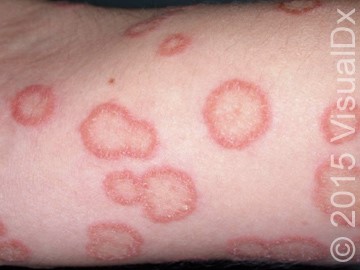Published on
Differential Diagnosis
- Granuloma annulare
- Nummular dermatitis
- Psoriasis
- Tinea corporis

Diagnosis
This patient was diagnosed with tinea corporis—sometimes termed “ring worm.” It represents a skin infection by a dermatophyte species of fungus (either Trichophyton, Microsporum, or Epidermophyton).
Learnings
- Fungal organisms are transmitted to humans by direct contact with animals (which likely occurred in this case) or other people, or through fomites
- Tinea corporis usually appears as annular, erythematous, scaling plaques
- Infection may be pruritic or asymptomatic
- Disseminated tinea corporis may be seen in patients with diabetes, Cushing syndrome, malignancy, old age, or who are immunocompromised
Pearls for Urgent Care Management and Considerations for Transfer
- Treatment is tailored toward the fungal infection, underlying predisposing factors, and keeping the intertriginous areas as dry as possible
- Initial treatment could be a 7–14-day course of a topical antifungal cream, such as miconazole or clotrimazole
- Resistant cases may require oral antifungal agents, such as ketoconazole 22 mg/day or fluconazole 100 mg/day for 4–6 weeks
- Drying agents, such as cornstarch, talcum powder, or antifungal powders may be helpful in minimizing skin fold moisture
A 40-Year-Old Veterinarian with Scaly Lesions
1 2
